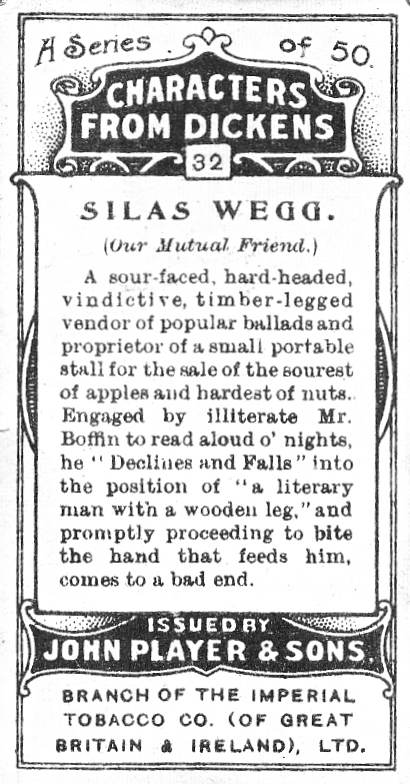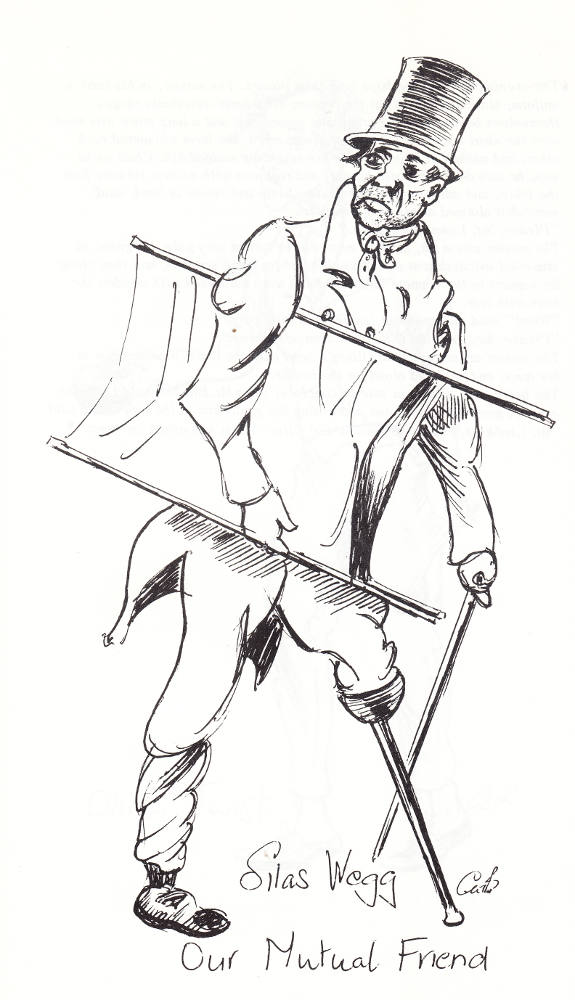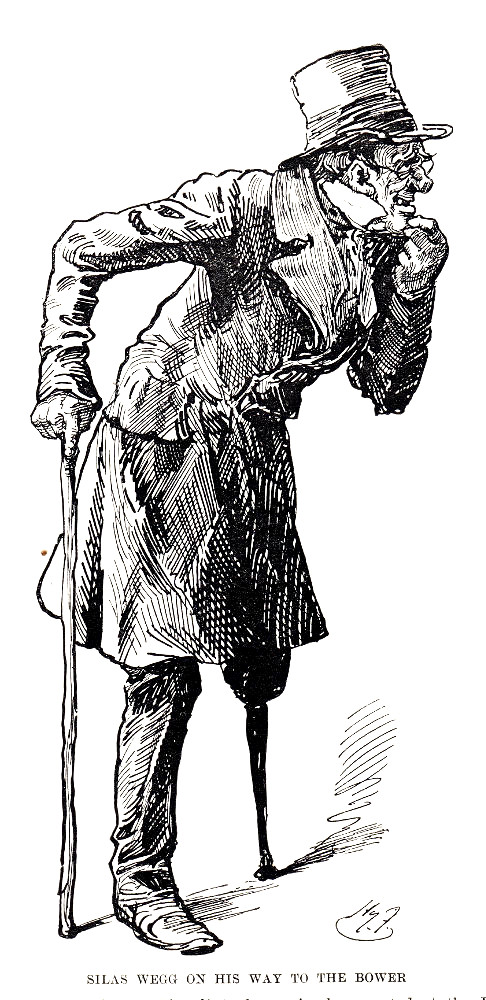

Silas Wegg by J. Clayton Clarke (“Kyd”) for the watercolour series (1910): reproduced on John Player cigarette card no. 32: Ninety-two Characters from Dickens: Our Mutual Friend. 2 ½ inches high by 1 ¼ inches wide (6.3 cm high by 3.3 cm wide). [Click on the images to enlarge them.]
SILAS WEGG. (Our Mutual Friend.)
A sour-faced, hard-headed, vindictive, timber-legged vendor of popular ballads and proprietor of a small portable stall for the sale of the sourest of apples and hardest of nuts. Engaged by illiterate Mr. Boffin to read aloud o' nights, he “Declines and Falls” into the position of “a literary man with a wooden leg,” and promptly proceeding to bite the hand that feeds him, comes to a bad end. [Verso of Card No. 32]
Passages Suggested by Illustration: Boffin Encounters Wegg

Right: Marcus Stone's April 1865 serial illustration of Silas Wegg: The Evil Genius of the House of Boffin in Book III, Chapter VII, “The Friendly Move Takes up a Strong Position,”436.
‘A knotty man, and a close-grained, with a face carved out of a very hard material, that had just as much play of expression as a watchman’s rattle. When he laughed, certain jerks occured [sic] in it, and the rattle sprung. Sooth to say, he was so wooden a man that he seemed to have taken his wooden leg naturally, and rather suggested to be the fanciful observer, that he might completely set up — if his development received no untimely check — to be completely set up with a pair of wooden legs in about six months . . .
Every morning at eight o’clock, he stumped to the corner, carrying a chair, a clothes-horse, a pair of trestles, a board, a basket, and an umbrella, all strapped together. Separating these, the board and trestles became a counter, the basket supplied the few small lots of fruit and sweets that he offered for sale upon it and became a foot-warmer, the unfolded clothes-horse displayed a choice collection of halfpenny ballads and became a screen, and the stool planted within it became his post for the rest of the day.
“I listened with hadmeration amounting to haw. I thought to myself, “Here's a man with a wooden leg. . .
‘“A literary man — with a wooden leg — and all Print is open to him!” That’s what I thought to myself, that morning,’ pursued Mr. Boffin. . . . [Household Edition, Book One, Chapter V, “Boffin's Bower,” cited in Brigden, 33]
Commentary: A Very Late But Truly "Dickensey" Character

Although Kyd's representations of the two characters from Our Mutual Friend (May 1864-November 1865) are largely based on the original serial illustrations by the realist Marcus Stone, Kyd's modelling of the figures of Silas Wegg and Rogue Riderhood is strongly suggestive of those of the late Dickens illustrator James Mahoney for the Household Edition, Volume IX (1875). The anomaly, of course, is that Kyd should elect to depict minor figures from the first Dickens novel such as the Dingley Dell cricketers Dumkins and Luffey, but should omit significant characters from such later, still-much-read novels as A Tale of Two Cities and Great Expectations — characters, moreover, like Pumblechook and Magwitch from Great Expectations who had appeared in the chromolithographs of Character Sketches of Charles Dickens as Pourtrayed by Kyd (24 illustrations, 1889) and Some Well Known Characters from the Works of Charles Dickens (1892), the former published by Raphael Tuck, London, and the latter by Hildesheimer and Faulkner, London.
The Dickens reader at the fin de siècle must have been surprised to find missing from Kyd's character sketches such significant figures in Our Mutual Friend as the depraved, obsessive school-master, Bradley Headstone; Lizzie Hexam and her father, the Thames waterman Gaffer; the story's chief love interest, Bella Wilfer; the doll's dressmaker, the sharp-tongued Jenny Wren; the deceptive socialite (secretly a money-lender) Fascination Fledgby; his put-upon employee, Riah; and the Golden Dustman, Noddy Boffin. Since these late Dickens characters had plenty to offer the illustrator, one must assume that Kyd fashioned his short list for the cigarette card series according to the popular taste, even though his books contain images of the Analytical Chemist (the Veneerings' butler) and Fascination Fledgby. However, he does include from his books the image of the spiteful Wegg, the one-legged street vendor whom Boffin hires to read to him:

James Mahoney's initial Household Edition illustration of Silas Wegg: “Here you are again,” repeated Mr. Wegg, musing in Chapter V, “Boffin's Bower,” 24.
Over against a London house, a corner house not far from Cavendish Square, a man with a wooden leg had sat for some years, with his remaining foot in a basket in cold weather, picking up a living on this wise: — Every morning at eight o'clock, he stumped to the corner, carrying a chair, a clothes-horse, a pair of trestles, a board, a basket, and an umbrella, all strapped together. Separating these, the board and trestles became a counter, the basket supplied the few small lots of fruit and sweets that he offered for sale upon it and became a foot-warmer, the unfolded clothes-horse displayed a choice collection of halfpenny ballads and became a screen, and the stool planted within it became his post for the rest of the day. All weathers saw the man at the post. This is to be accepted in a double sense, for he contrived a back to his wooden stool, by placing it against the lamp-post. When the weather was wet, he put up his umbrella over his stock in trade, not over himself; when the weather was dry, he furled that faded article, tied it round with a piece of yarn, and laid it cross-wise under the trestles: where it looked like an unwholesomely-forced lettuce that had lost in colour and crispness what it had gained in size. [Household Edition, Book One, Chapter V, "Boffin's Bower," pp. 22-23]
Silas Wegg in the original and later editions, 1865-1910

Right: Harry Furniss's fifth Charles Dickens Library Edition illustration: Silas Wegg on his way to the Bower in Chapter VII, “Mr. Wegg looks after himself,” facing p. 80.
The model for Kyd's interpretation is Marcus Stone's original serial image, the May 1865 instalment's The Evil Genius of the House of Boffin (Book III, "A Long Lane," Chapter VII, "The Friendly Move Takes up a Strong Position"). However, Kyd has also utilized Mahoney's illustrations of the serio-comic figure, typically "Dickensian" in his peculiar obsession with his lost leg. In "Here you are again," repeated Mr. Wegg, musing. "And what are you now?" (Book One, "The Cup and the Lip," Chapter 5) and "You're casting your eye round the shop, Mr. Wegg. Let me show you a light" (Book One, Chapter 8), set in the shop of the taxidermeist, Mr. Venus, Kyd found useful images, but elected to give his Wegg a far more surly, suspicious facial expression, and greater animation than the Mahoney figure in such large-scale Household Edition illustrations as Mr. Venus produced the document, holding on by his usual corner. Mr. Wegg, holding on by the opposite corner, sat down on the seat so lately vacated by Mr. Boffin, and looked it over (Book III, Chapter XVII, "Mr. Wegg prepares a grindstone for Mr. Boffin's Nose," 246).



Left: Sol Eytinge, Junior's study in contrasts, the somewhat dreamy taxidermist and his piratical partner, in Venus's shop, Mr. Wegg and Mr. Venus in Consultation (1867). Centre: Marcus Stone's second June 1865 serial illustration of the plotters' meeting in Mr. Venus curiously stocked taxidermy shop, Mr. Wegg prepares a grindstone for Mr. Boffin's Nose. (Part 14). Right: Felix Octavius Carr Darley's depiction of Wegg as the keeper of a street stall, Mr. Boffin engages Mr. Wegg. [Click on the images to enlarge them.]
Related Materials
- Illustrations by Marcus Stone (40 plates from the Chapman and Hall edition of May 1864 through November 1865)
- Frontispieces by Octavius Carr Darley (4 photogravures from the Hurd and Houghton Household Edition of 1866)
- Illustrations by Sol Eytinge, Jr. (16 plates from the Ticknor and Fields' Diamond Edition of 1867)
- James Mahoney (58 plates from the Chapman and Hall Household Edition of 1875)
- Harry Furniss (28 lithographs from the Charles Dickens Library Edition, Vol. XV, 1910)
- Clayton J. Clarke (two studies from his designs for the Player's Cigarette Cards, 1910)
Scanned images and text by Philip V. Allingham. [You may use these images without prior permission for any scholarly or educational purpose as long as you (1) credit the person who scanned the images and (2) link your document to this URL in a web document or cite the Victorian Web in a print one.]
Bibliography
Bentley, Nicolas, Michael Slater, and Nina Burgis. The Dickens Index. Oxford and New York: Oxford U. P., 1988.
Brigden, C. A. T. "No. 17. Silas Wegg." The Characters from Charles Dickens as depicted by Kyd. Rochester, Kent: John Hallewell, 1978.
The Characters of Charles Dickens Pourtrayed in a Series of Original Water Colour Sketches by “Kyd.” London, Paris, and New York: Raphael Tuck & Sons, 1898[?].
Davis, Paul. Charles Dickens A to Z: The Essential Reference to His Life and Work. New York: Checkmark and Facts On File, 1999.
Dickens, Charles. Our Mutual Friend. Illustrated by Marcus Stone. The Authentic Edition. Vol. 14. London: Chapman and Hall, 1901.
Dickens, Charles. Our Mutual Friend. Frontispieces by Felix Octavius Carr Darley and Sir John Gilbert. The Household Edition. 55 vols. New York: Sheldon & Co., 1863. 4 vols.
Dickens, Charles. Our Mutual Friend. Illustrated by Sol Eytinge, Jr. The Diamond Edition. Boston: Ticknor & Fields, 1867. 14 vols.
Dickens, Charles. Our Mutual Friend. Illustrated by James Mahoney. The Household Edition. 22 vols. London: Chapman and Hall, 1875. Volume IX.
Dickens, Charles. Our Mutual Friend. Illustrated by Harry Furniss. The Charles Dickens Library Edition. 18 vols. London: Educational Book, 1910. Vol. XV.
Hammerton, J. A. "Chapter 21: The Other Novels." The Dickens Picture-Book. The Charles Dickens Library Edition. Illustrated by Harry Furniss. 18 vols. London: Educational Book Co., 1910. Vol. XVII. 441-442.
Vann, J. Don. "Our Mutual Friend, twenty parts in nineteen monthly instalments, May 1864—November 1865." Victorian Novels in Serial. New York: The Modern Language Association, 1985. 74.
Created 17 January 2015
Last modified 24 July 2025